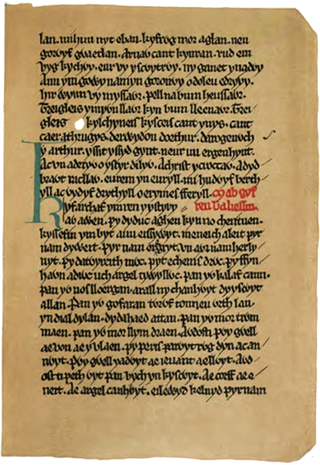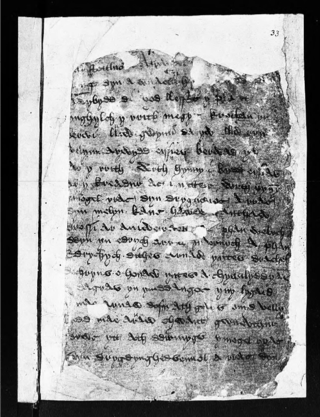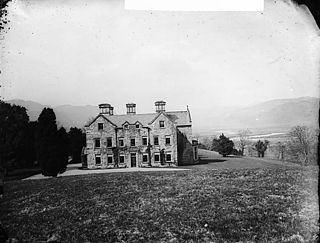
The National Library of Wales, in Aberystwyth, is the national legal deposit library of Wales and is one of the Welsh Government sponsored bodies. It is the biggest library in Wales, holding over 6.5 million books and periodicals, and the largest collections of archives, portraits, maps, and photographic images in Wales. The Library is also home to the national collection of Welsh manuscripts, the National Screen and Sound Archive of Wales, and the most comprehensive collection of paintings and topographical prints in Wales. As the primary research library and archive in Wales and one of the largest research libraries in the United Kingdom, the National Library is a member of Research Libraries UK (RLUK) and the Consortium of European Research Libraries (CERL).
The Hengwrt Chaucer manuscript is an early-15th-century manuscript of the Canterbury Tales, held in the National Library of Wales, in Aberystwyth. It is an important source for Chaucer's text, and was possibly written by someone with access to an original authorial holograph, now lost.

The White Book of Rhydderch is one of the most notable and celebrated surviving manuscripts in Welsh. Mostly written in southwest Wales in the middle of the 14th century it is the earliest collection of Welsh prose texts, though it also contains some examples of early Welsh poetry. It is now part of the collection of the National Library of Wales, having been preserved in the library at Hengwrt, near Dolgellau, Gwynedd, of the 17th century antiquary Robert Vaughan, who inherited it from the calligrapher John Jones and passed it to his descendants. The collection later passed to the newly established National Library of Wales as the Peniarth or Hengwrt-Peniarth Manuscripts.

The Black Book of Carmarthen is thought to be the earliest surviving manuscript written solely in Welsh. The book dates from the mid-13th century; its name comes from its association with the Priory of St. John the Evangelist and Teulyddog at Carmarthen, and is referred to as black due to the colour of its binding. It is currently part of the collection of the National Library of Wales, where it is catalogued as NLW Peniarth MS 1.

The Book of Taliesin is one of the most famous of Middle Welsh manuscripts, dating from the first half of the 14th century though many of the fifty-six poems it preserves are taken to originate in the 10th century or before.
Rhun ap Maelgwn Gwynedd, also known as Rhun Hir ap Maelgwn Gwynedd, sometimes spelt as 'Rhûn', was King of Gwynedd. He came to the throne on the death of his father, King Maelgwn Gwynedd. There are no historical records of his reign in this early age. A story preserved in both the Venedotian Code and an elegy by Taliesin says that he waged a war against Rhydderch Hael of Alt Clut and the kings of Gododdin or Manaw Gododdin. The small scattered settlement of Caerhun in the Conwy valley is said to be named for him, though without strong authority. Rhun also appears in several medieval literary stories, as well as in the Welsh Triads. His wife was Perwyr ferch Rhûn "Ryfeddfawr" and their son was Beli ap Rhun "Hîr".

Cyfraith Hywel, also known as Welsh law, was the system of law practised in medieval Wales before its final conquest by England. Subsequently, the Welsh law's criminal codes were superseded by the Statute of Rhuddlan in AD 1284 and its civil codes by Henry VIII's series of Laws in Wales Acts between 1535 and 1542.

Rhydderch Hael, Riderch I of Alt Clut, or Rhydderch of Strathclyde, was a ruler of Alt Clut, a Brittonic kingdom in the Hen Ogledd or "Old North" of Britain. He was one of the most famous kings in the Hen Ogledd, and appears frequently in later medieval works in Welsh and Latin.
Ieuan ab Owain Glyndŵr was reputedly the illegitimate son of Owain Glyndŵr, the last native-Welsh Prince of Wales. The possibility of his existence was uncovered through the work of Peter Bartrum which is currently being edited by the University of Wales Aberystwyth. Ieuan ab Owain and his descendants are detailed in Peniarth Manuscript 287 in the hand of Robert Vaughan of Hengwrt (c.1592–1667) and also in the manuscript known as Harley 1969 by Griffith Hughes (1634–1665) - the original manuscripts are kept at the National Library of Wales, Aberystwyth and the British Library respectively.

Deganwy Castle was an early stronghold of Gwynedd in Deganwy, at the mouth of the River Conwy in Conwy, north Wales. It sits at an elevation of 110 m (361 ft) on a volcanic plug in an area of limestone known as the Vardre.

Elfael was one of a number of Welsh cantrefi occupying the region between the River Wye and river Severn, known as Rhwng Gwy a Hafren, in the early Middle Ages. It was divided into two commotes, Is Mynydd and Uwch Mynydd, separated by the chain of hills above Aberedw. In the late medieval period, it was a marcher lordship. However, after the Laws in Wales Act 1535, it was one of the territorial units which went to make up the county of Radnorshire in 1536.
Robert Powell Vaughan was an eminent Welsh antiquary and collector of manuscripts. His collection, later known as the Hengwrt–Peniarth Library from the houses in which it was successively preserved, formed the nucleus of the National Library of Wales, and is still in its care.
Ieuan ap Rhydderch ab Ieuan Llwyd was a Welsh bard.
William Maurice (1620–1680) was a well-known seventeenth-century collector and transcriber of Welsh manuscripts and books from Denbighshire, Wales.

The Peniarth Manuscripts, also known as the Hengwrt–Peniarth Manuscripts, are a collection of medieval Welsh manuscripts now held by the National Library of Wales in Aberystwyth. The collection was originally assembled by Robert Vaughan of Hengwrt, Merionethshire. During the 19th century it was held in Peniarth Mansion, Llanegryn.
Wales has produced a number of manuscripts over the centuries. Although most were written in Middle Welsh or Old Welsh, some were also written in Latin. In some of the more recent manuscripts it is not uncommon to have texts in Welsh, Latin, French and English in the same volume. However, some of the most important medieval manuscripts were written in Latin only, e.g. the Cyfraith Hywel.

Peniarth 51, otherwise known as Llyfr Gwilym Tew, is a Welsh manuscript written in the second half of the 15th century. It is mostly in the hand of the bard Gwilym Tew. Although it is known that Gwilym wrote other manuscripts, Peniarth 51 is the only entire manuscript that can be proven to have been his work. It is kept in the National Library of Wales, Aberystwyth, as part of the Peniarth Manuscripts collection.

Hengwrt was a mansion near Dolgellau in Meirionnydd, Gwynedd. It lay in the parish of Llanelltyd near the confluence of the River Mawddach and River Wnion, near Cymer Abbey. With medieval origins, it was rebuilt or remodelled on several occasions before being demolished in 1962. It is remembered as the original home of the important collection of the Peniarth Manuscripts, now in the National Library of Wales.
Thomas Wiliems was a Welsh-language antiquarian.